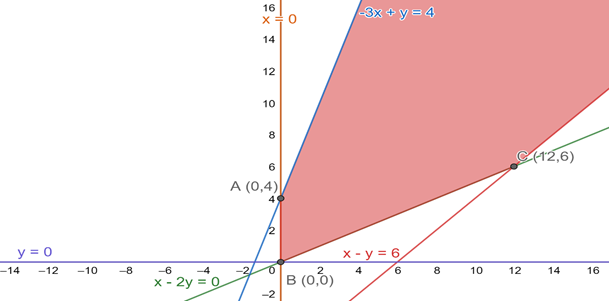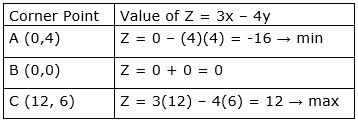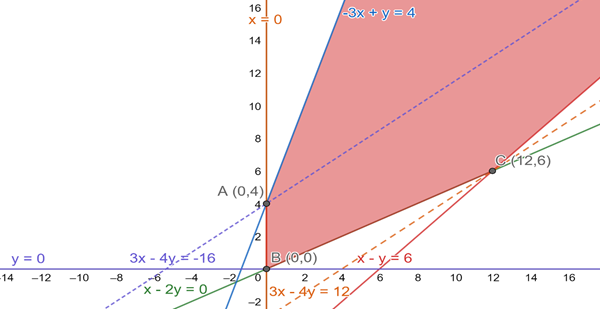Maximise and Minimise Z = 3x – 4y
subject to x – 2y ≤ 0
– 3x + y ≤ 4
x – y ≤ 6
x, y ≥ 0
We have constraints,
x – 2y ≤ 0
– 3x + y ≤ 4
x – y ≤ 6
x, y ≥ 0
Z = 3x – 4y
We need to maximize and minimize Z, subject to the given constraints.
Now let us convert the given inequalities into equation.
We obtain the following equation
x – 2y ≤ 0
⇒ x - 2y = 0
– 3x + y ≤ 4
⇒ -3x + y = 4
x – y ≤ 6
⇒ x - y = 6
x ≥ 0
⇒ x=0
y ≥ 0
⇒ y=0
The region represented by x – 2y ≤ 0:
The line x - 2y = 0 meets the coordinate axes at origin and slope of the line is ![]() . We will construct a line passing through origin and whose slope is
. We will construct a line passing through origin and whose slope is ![]() . As point (1,1) satisfies the inequality. So, the side of line which contains (1,1) is feasible. Hence, the solution set of the inequation x – 2y ≤ 0 is the side which contains (1,1).
. As point (1,1) satisfies the inequality. So, the side of line which contains (1,1) is feasible. Hence, the solution set of the inequation x – 2y ≤ 0 is the side which contains (1,1).
The region represented by – 3x + y ≤ 4:
The line – 3x + y = 4 meets the coordinate axes ![]() and (0,4) respectively. We will join these points to obtain the line x + y = 7. It is clear that (0,0) satisfies the inequation – 3x + y ≤ 4. So, the region containing the origin represents the solution set of the inequation – 3x + y ≤ 4.
and (0,4) respectively. We will join these points to obtain the line x + y = 7. It is clear that (0,0) satisfies the inequation – 3x + y ≤ 4. So, the region containing the origin represents the solution set of the inequation – 3x + y ≤ 4.
The region represented by x – y ≤ 6:
The line x – y = 6meets the coordinate axes (6,0) and (0,-6) respectively. We will join these points to obtain the line x – y = 6. It is clear that (0,0) satisfies the inequation x – y ≤ 6. So, the region containing the origin represents the solution set of the inequation x – y ≤ 6.
Region represented by x≥0 and y≥0 is first quadrant, since every point in the first quadrant satisfies these inequations.
Plotting these equations graphically, we get

The feasible region is region between line -3x + y = 4 and x – y = 6, above BC and to the right of y – axis as shown.
Feasible region is unbounded.
Corner points are A, B, C
So, maximum value of Z at corner points is 12 at C and minimum is -16 at A.
Value of Z at corner points A, B, C and D –

So, to check if the solution is correct, we plot 3x – 4y > 12 and 3x – 4y < -16 for maximum and minimum respectively.
The region represented by 3x – 4y > 12:
The line 3x – 4y = 12 meets the coordinate axes (4,0) and (0,-3) respectively. We will join these points to obtain the line 3x – 4y > 12. It is clear that (0,0) does not satisfy the inequation 3x – 4y > 12. So, the region not containing the origin represents the solution set of the inequation 3x – 4y > 12.
The region represented by 3x – 4y <-16:
The line 3x – 4y = -16 meets the coordinate axes ![]() and (0,4) respectively. We will join these points to obtain the line 3x – 4y <-16. It is clear that (0,0) does not satisfy the inequation 3x – 4y <-16. So, the region not containing the origin represents the solution set of the inequation 3x – 4y <-16.
and (0,4) respectively. We will join these points to obtain the line 3x – 4y <-16. It is clear that (0,0) does not satisfy the inequation 3x – 4y <-16. So, the region not containing the origin represents the solution set of the inequation 3x – 4y <-16.
We get,

Clearly, 3x – 4y = 12 has no point inside feasible region, but 3x -4y = -16 passes through the feasible region.
Therefore, Z has no minimum value it has only a maximum value which is 12.